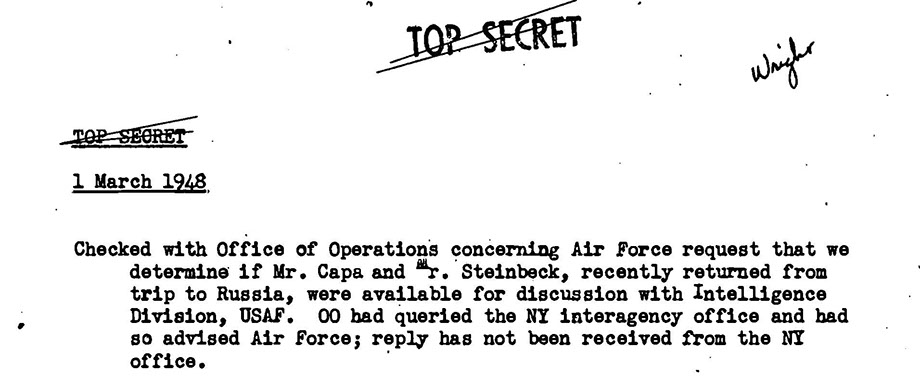steinbeck: citizen spy
The untold story of John Steinbeck and the CIA
CIA and USAF Show Interest John Steinbeck and Robert Capa's A Russian Journal Trip
Released in 2016, but not made available on the CIA’s FOIA Electronic Reading Room until 2018, the March 1948 briefings of Director of Central Intelligence (DCI) Roscoe H. Hillenkoetter contains an entry that refers to John Steinbeck and Robert Capa’s 1947 trip to the Soviet Union. The CIA had full knowledge of the A Russian Journal trip and the United States Air Force (USAF) was interested too.
In CIA Document Number (FOIA) /ESDN (CREST):5166d49399326091c6a6049d, or more easily digested, DCI Roscoe H. Hillenkoetter’s March 1948 briefings, the following entry appears for 1 March:
1 March 1948 — Checked with Office of Operations concerning Air Force request that we determine if Mr. Capa and Mr. Steinbeck, recently returned from trip to Russia, were available for discussion with Intelligence Division, USAF. OO [Office of Operations] had queried the NY interagency office and had so advised Air Force reply has not been received from the NY office.

Image of DCI Roscoe H. Hillenkoetter's March 1948 daily briefing.
This one entry elucidates several things about Steinbeck’s 1947 trip to the Soviet Union. First and foremost, the Air Force Intelligence Division is asking permission from the CIA to interview Steinbeck and Capa. The CIA is not known for keeping up with civilians’ social calendars. There would be no need for Air Force Intelligence to ask the CIA if Steinbeck and Capa “were available for discussion” unless they were known in intelligence circles to be CIA assets. Wither the CIA recruited Steinbeck and Capa before or after their 1947 Soviet Union trip, is still unknown.
It was speculated in Steinbeck: Citizen Spy that John Steinbeck plays a spy game within A Russian Journal with regards to his knowledge of air power:
Steinbeck even fibs a little about his capability as an observer within A Russian Journal. In attending an air show in Moscow, Steinbeck mentions that it was ridiculous that Capa wasn’t allowed to take pictures of military aircraft. Military attachés from any Embassy could attend, seeing the military hardware firsthand. Steinbeck goes on to say that he and Capa 'didn’t know an airplane from a hole in the ground.'
But Steinbeck did know quite a bit more about airplanes than a “hole in the ground.” In mid-August of 1940, John had taken flying lessons at the Palo Alto airport. More importantly, Steinbeck spent May and June of 1942 with a B-17 aircrew gathering materials for the book Bombs Away. Steinbeck knew more about aircraft than the average civilian spectator. Even within A Russian Journal, Steinbeck makes knowledgeable observations on the poor state of the Soviet’s aging lend-lease era C-47 cargo aircraft. Steinbeck might not have been that familiar with Soviet aircraft types, but the gaffe is reminiscent of John’s writing for the New York Herald Tribune. During the war, John had to either change or omit facts about troop strengths, locations, and dates to pass military censors. There’s little use in keeping operational security if all the pertinent details of an action are printed in this week’s Sunday Edition. Steinbeck’s articles would usually rely on recounting quirky stories that had little to do with military hardware or operations. The notable exceptions to Steinbeck’s pattern are his articles about the Beach Jumpers and Salerno. In these pieces, actual events were slightly distorted to pass the censor’s desk. For example, larger-than-life Douglas Fairbanks is split into two different characters in Steinbeck’s articles. It would appear that when writing up the events of the Soviet air show, Steinbeck fell back into old habits. The difference in 1947 was that if Steinbeck was passing information back to the American Embassy, John was shielding his own abilities.
If Air Force Intelligence was keen to speak with Steinbeck, we can surmise he had something of value to say.
Another clue in Hillenkoetter’s briefing is that not only was this information worthy of the DCI’s attention, but the Air Force’s request was made to the Office of Operations. In 1948 the CIA’s Office of Operations is analogous to today’s Directorate of Operations. The mission of the Directorate of Operations is according to the CIA’s website:
The Directorate of Operations (DO) serves as the clandestine arm of the Central Intelligence Agency (CIA) and the national authority for the coordination, de-confliction, and evaluation of clandestine operations across the Intelligence Community of the United States.
We can only speculate as to why the clandestine arm of the CIA was overseeing Steinbeck and Capa. Possibly other documents will come forward to define their precise relationship. Until then, we’ll keep digging though the archives to get to the truth.
